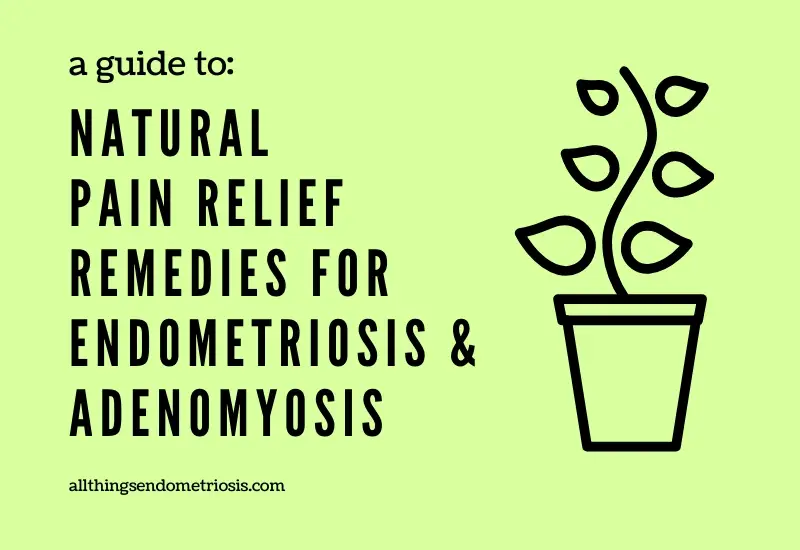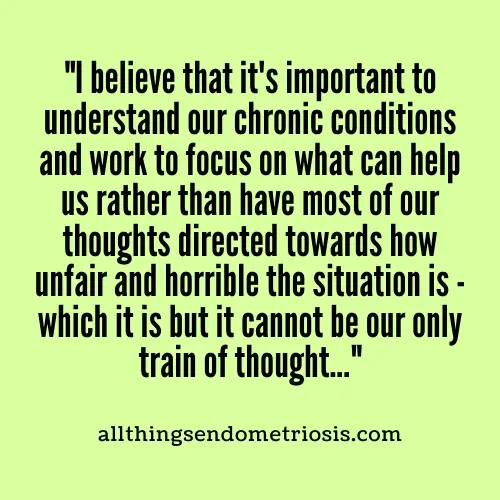
Debilitating pain, cramping, nausea, dizziness all seem to love endometriosis and adenomyosis patients. But how does one try to get some relief from these symptoms? I’ve put together a list of things I do to help myself.
Please remember: these are remedies that work on occasion for me. I am not a medical professional so please consult your doctor to make sure these remedies are allowed for you.
Firstly, What Does Endometriosis and Adenomyosis Pain Feel Like?
I have been asked on many occasions “what does the pain feel like?” and I have always found it challenging to explain what the pain of endometriosis and adenomyosis feels like because we all have had different experiences of pain and we all have different pain thresholds too.
But I also feel it’s important for patients to be able to describe their pain – there’s a strange connect that we endo-warriors feel when our pains are described well – it’s as if someone understands. It has this calming effect that someone gets me. I’m not alone.
That calming effect aids as a mental pain releaser – almost cathartic. Has anyone else experienced this?
So before I explain the natural pain relief methods I use for endometriosis and adenomyosis, here’s what the pain feels like – at least for me. Also, such descriptions help when I need to explain my pains to the doctor.
Relevant Read:
(Trigger Warning – this could be too descriptive for some. Please scroll down for natural pain relief methods if you wish to.)
I experience sharp piercing pains during my severe cramping episodes – my entire abdomen and lower back goes into a spasm where every little move disables me further. At the same time, I feel as if my abdomen has been set ablaze – the burning is horrendous – I can feel these balls of fire moving around.
Then there are times when I feel someone is crushing my pelvis and squeezing my insides. This makes me scream and cry out loud.
During lesser dramatic times, the pain will feel like a fresh bruise that is constantly being pressed.
With that explained and possible pain levels established, let’s move on to the pain relief methods I use…
If you wish to see a video version of this article then you can right here (or you can scroll down for the text version).
O’ if you like the video then please do share, like and subscribe to my YouTube channel please. Thank you:
Nine Natural Pain Relief Remedies for Endometriosis & Adenomyosis Patients
I believe that it’s important to understand our chronic conditions and work to focus on what can help us rather than have most of our thoughts directed to how unfair and horrible the situation is – which it is but it cannot be our dominant train of thought.
Pain can really drain you of all your energy and so, when an endometriosis and an adenomyosis flare-up happens, you wish for something that will immediately take the pains away.
Unfortunately there isn’t a miracle remedy out there (at least nothing that I have come across) but what we can do is build a routine that incorporates some of the remedies below.
1. Hot Water Bag
A hot water bag is my absolute favourite!
Heat helps to calm cramping muscles and improves mobility. For me pain usually radiates down my leg so this helps my leg pain too.
I would also recommend a warm shower. This helps in exactly the same way except I feel that its effects are temporary. A hot water bag can be a longer companion especially when you want to sleep through the pain.
2. Castor Oil Massages
At night, after a warm shower, I tend to gently massage castor oil on my abdomen, wear a t-shirt on top and place my hot water bag on top so that the heat can help the castor oil to penetrate further in.
But how does this help?
Castor oil is known to improve blood circulation, help stagnant tissue and reduce inflammation. But do remember, castor oil packs/massages are not recommended while you are on your period, which is why I tend to do these castor oil massages as a build up towards my period days all in the hope that I have a period where the pain is lesser than usual.
3. Ginger Turmeric Tea
My stomach churns and I go through loads of nausea during my periods and in the build up to it, but since I added ginger turmeric tea to my routine I’ve found it to be immensely helpful in calming my desire to throw up.
The ginger helps with this nausea.
Ginger and turmeric are both anti-inflammatories and antioxidants, so sipping away on this herbal tea regularly helps to reduce my overall pains and joint stiffness too.
I always get my organic ginger-turmeric tea from Bushwick Tea. They’ve kindly offered to give a 10% discount to all of you on any of their organic teas if you use my code: ATE10
If you’re into teas like me, then do read this:
View this post on Instagram
4. Stretching
A very important aspect of my routine.
Whether I am going through endometriosis pain or menstrual pain (dysmenorrhea) or whether I am having a reduced pain day, stretching is crucial.
In all the pain we go through plus our sedentary lifestyles, muscle stiffness is bound to happen and when you add a bad endo flare-up, you’re inviting additional trouble.
Therefore, I would recommend light abdomen, legs and lower back stretches but please do seek out a physiotherapist who can recommend the right stretches for your specific issues. Even pelvic floor therapy is extremely helpful as it strengthens your pelvic muscles.
Making this a part of your routine should bring with it long-term benefits.
Read Here For:
- Connecting Endometriosis and Ehlers-Danlos Syndrome
- The Relation Between Endometriosis / EDS and Chronic Fatigue
- How Much Does Laparoscopic Endometriosis Excision Surgery Cost?
5. Endometriosis Diet
I have made a lot of changes to my diet which deserves a post of its own, but I will explain it all briefly here until I write something more comprehensive.
Before I explain this further, I do wish to add that I don’t just have endometriosis and adenomyosis, I also have Ehlers-Danlos syndrome, chronic fatigue syndrome, fibromyalgia and painful bladder syndrome so for me a diet change was necessary.
Relevant Read:
- My MCAS Journey: “It’s Not a UTI, It’s Painful Bladder Syndrome!”
- Being Diagnosed with Ehlers-Danlos Syndrome
My diet is mainly gluten free – gluten is overly filling, makes me bloat and adds to my pains. This may not be the case with you but going gluten free has aided in reducing my bloating – especially the annoying endo-belly.
I look to avoid anything with added hormones, which includes dairy products and meats.
Since endometriosis, adenomyosis and even PCOS are hormonally driven medical conditions, it therefore never made sense to me to complicate my body with foreign, injected hormones – frankly it shouldn’t be good for anyone but it is a personal choice but for me it aids in my battle against these diseases.
Plus, please note – I have consulted a nutritionist to make sure I am receiving my protein and calcium from other sources. I would recommend you do the same before making major dietary changes.
Click here for a more in-depth guide to my anti-inflammatory endometriosis, adenomyosis and Ehlers-Danlos syndrome diet.

6. Psyllium Husk
A natural laxative – made from the husks of the Plantago Ovata Plant’s seeds, psyllium husk is a form of fibre.
When you have endometriosis, especially in the bowel region, applying extra pressure when on the toilet seat is usually not a great idea and endometriosis has a way of causing constipation.
A couple of spoons of psyllium husk with warm water four to five days a week has been an absolute blessing – especially after my endometriosis excision surgery where applying pressure with all the stitches was going to be too painful.
Again, please seek the advice of a medical professional before incorporating this habit.
7. Salt & Ajwain
Helps beat the gassy feeling.
Many of us may not realise this, but gas can be quite a contributor to our pains.
To help reduce the accumulation of gas, I use this age-old remedy.
I place a quarter teaspoon of salt and a quarter teaspoon of ajwain (also known as bishop’s weed / carom) in the palm of my hand, mix it up a bit, chuck it in my mouth and drink some warm water on top.
Doing this at least once a day works well to ease my pains.
8. Pillows Help Too
During some of my worst pains, the pubic bone area can flare up, so I keep a thick pillow between the knees as I lie on my side. I believe the pillow creates space around the groin area and helps to reduce cramping.
9. Rest is Valuable
An obvious one, but it should be mentioned.
Resting is important because when in pain, your body is going through so much turmoil, so placing a hot water bottle on the abdomen or back and sipping some ginger turmeric tea or even trying to sleep through it just gives the body some much needed care.
My list now ends, but as I discover more natural pain relief remedies, I hope to add it here.
If you have any remedies that work for you, please do share in the comments below.
Thank you for reading 🙂
If you’re a social media person, then you can follow me on Instagram, Twitter, Facebook, Pinterest or YouTube.
I have a podcast too. You can check them out here along with their transcripts or if you don’t wanna read them then they’re available on Spotify and Apple Podcasts too.
~~~~~~~
Disclaimer: I am not a medical professional. I am a patient and have created this platform to share my experiences. This is all purely informative and in no way am I providing medical advice. Please consult a medical professional.


Great list Shruti! I haven’t tried psyllium husk before but heard a lot of people like to use it. Will have to ask my doctor if it’s OK for me if I ever need it.
Not just one but none, this is awesome! Hot water bottles can be such big help – I think they’re highly underrated! Thanks for this fab list!
I don’t have Endo, but I have Interstitial Cystitis (and am post menopausal); however, many of these things will help me, too. Thank you for sharing. Also, this may be a dumb question, but do all your issues with Endometriosis go away after menopause?